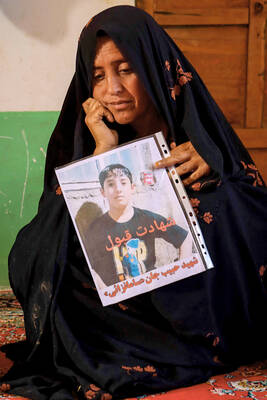Fire ripped through a high-rise apartment building south of Paris early yesterday, killing 14 people, two of them children, French officials said. Four people were detained in connection with the suspected arson attack.
The fire, the fourth deadly blaze in the Paris area since April, was quickly extinguished by firefighters, but 14 people died, mostly as a result of inhaling toxic smoke, officials said. About 500 people were in the 18-storey low-cost apartment building.
Witnesses described the screams of panicked residents or recalled leaping from windows as the blaze flared through the entrance hall of the building in the town of L'Hay-les-Roses in the Val-de-Marne region south of Paris.
Prime Minister Dominique de Villepin said in a statement that an investigation was under way into the fire, "that could be of criminal origin."
Mayor Patrick Seve said most of those who died had tried to flee the building through the entrance, and residents who stayed inside were not injured as temperatures soared.
"It was the people who rushed outside who were met with temperatures of 300 degrees [Celsius], smoke and asphyxiation," he said. "That's what caused the catastrophic toll."
Seve said witnesses claimed to have seen a group of youths who lived in the building start the fire. Police said four people had been taken in for questioning.
Jean-Luc Marx, a local government spokesman, said the apartment building had been constructed in the early 1970s as part of a state-supported plan for low-cost housing and recently underwent renovation, he said.
Firefighters said the inferno, which blackened the lobby, swept into a stairwell and raced up at least three floors, damaging several apartments. Authorities ordered about 500 people who remained inside to stay in their homes yesterday until it was deemed safe to come out.
"There was smoke, and people were screaming and wanted to jump," said resident Claude Camps, 48, who fled with his wife as the smoke had died down. "When we came out there was nothing left in the entry hall."
Ground floor resident Florence Zadi said she and her husband had leapt out of a window to safety after he opened their apartment door into a wall of smoke -- and quickly shut it.
About 200 firefighters rushed to the scene after the inferno erupted shortly after 1am yesterday and medical teams set up a mobile treatment site.
Sixteen people were injured -- at least 10 seriously, local fire brigade spokesman Alain Antonini said. Several were rushed to hospitals in the area. Two firefighters were among those lightly injured.
Five people were revived after suffering heart attacks, he said, and one pregnant woman who was rescued gave birth at the scene. She was taken to hospital with her newborn.
More than a dozen survivors who escaped were taken to safety at a nearby gymnasium. Authorities were preparing temporary lodging for the survivors, some of whom were expected to stay with relatives.
France has been grappling with how to deal with and prevent building fires, which have taken a heavy toll in the capital in recent months.
The government has announced a series of measures including the planned construction of new housing and the eviction of squatters from buildings considered fire hazards in the wake of three other blazes in Paris since April that killed 48 people -- mostly African immigrants.

Auschwitz survivor Eva Schloss, the stepsister of teenage diarist Anne Frank and a tireless educator about the horrors of the Holocaust, has died. She was 96. The Anne Frank Trust UK, of which Schloss was honorary president, said she died on Saturday in London, where she lived. Britain’s King Charles III said he was “privileged and proud” to have known Schloss, who cofounded the charitable trust to help young people challenge prejudice. “The horrors that she endured as a young woman are impossible to comprehend and yet she devoted the rest of her life to overcoming hatred and prejudice, promoting kindness, courage, understanding

US President Donald Trump on Friday said Washington was “locked and loaded” to respond if Iran killed protesters, prompting Tehran to warn that intervention would destabilize the region. Protesters and security forces on Thursday clashed in several Iranian cities, with six people reported killed, the first deaths since the unrest escalated. Shopkeepers in Tehran on Sunday last week went on strike over high prices and economic stagnation, actions that have since spread into a protest movement that has swept into other parts of the country. If Iran “violently kills peaceful protesters, which is their custom, the United States of America will come to

‘DISRESPECTFUL’: Katie Miller, the wife of Trump’s most influential adviser, drew ire by posting an image of Greenland in the colors of the US flag, captioning it ‘SOON’ US President Donald Trump on Sunday doubled down on his claim that Greenland should become part of the US, despite calls by the Danish prime minister to stop “threatening” the territory. Washington’s military intervention in Venezuela has reignited fears for Greenland, which Trump has repeatedly said he wants to annex, given its strategic location in the arctic. While aboard Air Force One en route to Washington, Trump reiterated the goal. “We need Greenland from the standpoint of national security, and Denmark is not going to be able to do it,” he said in response to a reporter’s question. “We’ll worry about Greenland in

PERILOUS JOURNEY: Over just a matter of days last month, about 1,600 Afghans who were at risk of perishing due to the cold weather were rescued in the mountains Habibullah set off from his home in western Afghanistan determined to find work in Iran, only for the 15-year-old to freeze to death while walking across the mountainous frontier. “He was forced to go, to bring food for the family,” his mother, Mah Jan, said at her mud home in Ghunjan village. “We have no food to eat, we have no clothes to wear. The house in which I live has no electricity, no water. I have no proper window, nothing to burn for heating,” she added, clutching a photograph of her son. Habibullah was one of at least 18 migrants who died